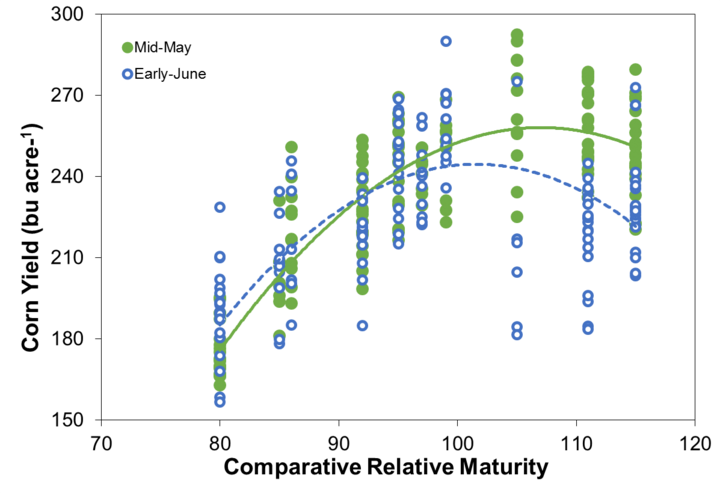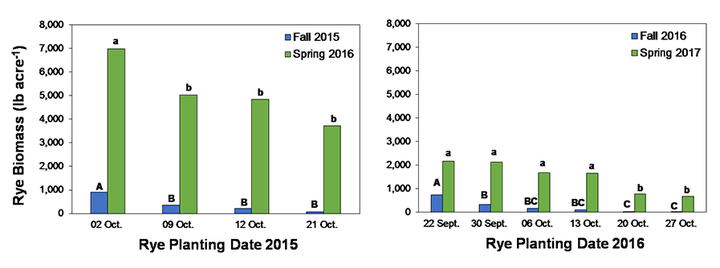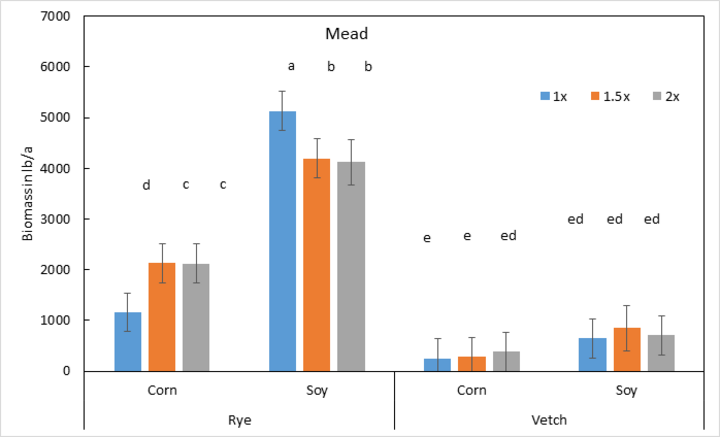Modifying Corn Management to Facilitate Earlier Cover Crop Establishment
A renewed interest by farmers to include cover crops between corn harvest and planting the succeeding crop is obliging agronomists to think differently about current cropping systems. Modifying corn management practices may facilitate increased cover crop use. The objective of this research was to understand the impact of planting dates, plant populations, and corn (Zea mays L.) hybrid comparative relative maturity (CRM) on corn growth, kernel moisture content, and corn yield. We used:
- mid-May and early-June planting dates;
- plant populations of 28000, 35000, and 42000 plants per acre-1; and
- corn CRM hybrids from 80 to 115 days.
Kernel moisture of 18% was reached by early and early to medium-maturity hybrids (less than 96 days) about one month earlier and medium-maturity hybrids (97 to 106 days) about 15 days earlier than late-maturity hybrids.
No differences in corn yield were observed between the medium and late-maturity hybrids planted at the earliest planting date. The greatest corn yield of 234 bu/acre-1 was obtained with a plant population of 35000 plants/acre-1 (Figure 1). Increasing CRM increased corn grain yield quadratically with the highest yield of 255 bu/acre-1 obtained with the 107 CRM hybrid planted in mid-May and 244 bu/acre-1 by 102 CRM hybrid when planted in early-June. Mid-May planting with a medium-maturity hybrid could optimize corn hybrid yield while permitting 15 days earlier planting of cover crops after corn harvest than current practices allow. Mid-May planting with an early to medium hybrid would penalize corn yield by 6%, but would allow cover crop planting 30 days earlier than current practices. These results provide evidence that early planting with earlier-maturity hybrids may increase the potential for use of cover crop in the corn-soybean cropping systems.

The Effect of Planting Date on Rye Biomass Production
Rye (Secale cereale L) is the most commonly used cover crop in the midwestern United States because of its wide adaptation range and ability to grow in the fall, overwinter, and resume growth in the spring. The benefits from rye depend in large part on the amount of biomass produced between corn harvest and planting of the succeeding crop. We conducted a field study of rye planting dates based on corn harvest dates of different relative maturity hybrids and planting dates to evaluate the impact on rye biomass production, and the subsequent soybean crop. Rye was planted Oct. 2, Oct. 9, Oct. 12, and Oct. 21 during 2015, and weekly from early September to late October in 2016. All plantings occurred after corn harvest.
Both fall and spring biomass had the most production with the earliest planting date (Figure 2). A positive linear relationship occurred between both fall and spring biomass production and growing degree days (GDDC.) Rye biomass production was greatest when at least 600 GDDC (base 0°C) accumulated between planting and fall sampling, and at least 975 GDDC (base 0°C) accumulated between planting and spring sampling under south central Nebraska conditions. This accumulation could be achieved by planting on or before Sept. 20.

Broadcast Seeding Rates for Rye and Hairy Vetch Cover Crops in No-Till Corn and Soybean Systems
Seed costs are major expenses when considering cover crops. Seeding rate recommendations for broadcast planting cover crops such as cereal rye and hairy vetch vary widely, but does increasing seeding rates lead to more cover crop biomass? Furthermore, cover crops broadcast into soybean stands may have different emergence and productivity than cover crops planted into corn stands. With this research, we determined cover crop seeding rates for high cover crop productivity in both corn and soybean systems.
Cover crops were planted at research stations near Mead and Clay Center, in late September of 2016 and 2017, by broadcasting by hand into corn and soybean. Rye seeding rates were 60, 90 and 120 lb/a. Vetch seeding rates were 40, 60 and 80 lb/a. Cover crop emergence was counted in the fall and biomass (as dry matter) was sampled in early May. All plots were no-till in 2016, but the plots at Mead were disked after cover crops termination in 2017. A significance level of 0.1 was used for statistical comparisons.
Cover crop emergence was higher in corn than in soybean. In corn, high amounts of residue and corn stubble may keep the soil surface moister and the seedling more protected from cold winds. On the other hand, in soybean, more light was reaching the seedlings, allowing growth of many tillers in rye, especially in the low seeding rate, whereas rye planted in corn had no tillers in any of the seeding rates. In the spring, rye biomass was highest at Mead, ranging from 1,100 to 5,200 lb/acre (Figure 3).
Biomass of rye growing in corn approximately doubled between the lowest and medium seeding rate, but was the same for the medium and highest seeding rates. Rye biomass in soybean did not differ as much between the seeding rates, probably because the lower seeding rates had the highest number of tillers. Vetch biomass was 500 lb/acre at Mead and 800 lb/acre at Clay Center and did not change with seeding rates. First-year results suggest that to maximize rye biomass, plant at 90 lb/acre into corn and at 60 lb/acre into soybean. Vetch can be planted at 40 lb/acre in either corn or soybean, but productivity is much lower than that of rye.

